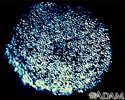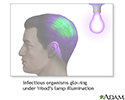Wood lamp examination
Black light test; Ultraviolet light testA Wood lamp examination is a test that uses ultraviolet (UV) light to look at the skin closely.
How the Test Is Performed
You sit in a dark room for this test. The test is usually done in a skin doctor's (dermatologist's) office. The doctor will turn on the Wood lamp and hold it 4 to 5 inches (10 to 12.5 centimeters) from the skin to look for color changes.
How to Prepare for the Test
You do not need to take any special steps before this test. Follow your doctor's instructions about not putting creams or medicines on the area of the skin before the test.
How the Test will Feel
You will have no discomfort during this test.
Why the Test Is Performed
This test is done to look for skin problems including:
- Bacterial infections
- Fungal infections
-
Porphyria (an inherited disorder that causes rashes, blistering, and scarring of the skin)
Porphyria
Porphyrias are a group of rare disorders in which an important part of hemoglobin, called heme, is not made properly. Hemoglobin is a protein in red...
 ImageRead Article Now Book Mark Article
ImageRead Article Now Book Mark ArticleRashes
Rashes involve changes in the color, feeling or texture of your skin.
 ImageRead Article Now Book Mark Article
ImageRead Article Now Book Mark ArticleBlistering
A vesicle is a small fluid-filled blister on the skin.
 ImageRead Article Now Book Mark Article
ImageRead Article Now Book Mark Article - Skin coloring changes, such as vitiligo and some skin cancers
Vitiligo
Vitiligo is a skin condition in which there is a loss of color (pigment) from areas of skin. This results in uneven white patches that have no pigme...
 ImageRead Article Now Book Mark Article
ImageRead Article Now Book Mark Article
Not all types of bacteria and fungi show up under the light.
Normal Results
Normally, the skin will not shine under the ultraviolet light.
What Abnormal Results Mean
A Wood lamp exam may help your doctor confirm a fungal or bacterial infection or diagnose vitiligo. Your doctor may also be able to learn what is causing any light- or dark-colored spots on your skin.
The following things can change the results of the test:
- Washing your skin before the test (may cause a false-negative result)
- A room that is not dark enough
- Other materials that glow under the light, such as some deodorants, make-up, soaps, and sometimes lint
Risks
Do not look directly into the ultraviolet light, as the light may harm the eye.
References
Dinulos JGH. Light-related diseases and disorders of pigmentation. In: Dinulos JGH, ed. Habif's Clinical Dermatology: A Color Guide to Diagnosis and Therapy. 7th ed. Philadelphia, PA: Elsevier; 2021:chap 19.
Spates ST. Diagnostic techniques. In: High WA, Prok LD, eds. Dermatology Secrets. 6th ed. Philadelphia, PA: Elsevier; 2021:chap 3.
-
Wood's lamp test - of the scalp - illustration
A Wood's lamp is a light that uses long wave ultraviolet light. When an area of scalp that is infected with tinea (a type of ringworm fungus) is viewed under a Wood's light, the fungus may glow. This test may be done to detect the presence of a fungal scalp or skin infection.
Wood's lamp test - of the scalp
illustration
-
Wood's lamp illumination - illustration
A Wood's lamp emits ultraviolet light and can be a diagnostic aid in determining if someone has a fungal or bacterial infection on the skin or scalp. If there is an infection on the area where the Wood's lamp is illuminating, the area will fluoresce. Normally the skin does not fluoresce, or shine, under ultraviolet light.
Wood's lamp illumination
illustration
-
Wood's lamp test - of the scalp - illustration
A Wood's lamp is a light that uses long wave ultraviolet light. When an area of scalp that is infected with tinea (a type of ringworm fungus) is viewed under a Wood's light, the fungus may glow. This test may be done to detect the presence of a fungal scalp or skin infection.
Wood's lamp test - of the scalp
illustration
-
Wood's lamp illumination - illustration
A Wood's lamp emits ultraviolet light and can be a diagnostic aid in determining if someone has a fungal or bacterial infection on the skin or scalp. If there is an infection on the area where the Wood's lamp is illuminating, the area will fluoresce. Normally the skin does not fluoresce, or shine, under ultraviolet light.
Wood's lamp illumination
illustration
Review Date: 10/14/2024
Reviewed By: Elika Hoss, MD, Assistant Professor of Dermatology, Mayo Clinic, Scottsdale, AZ. Also reviewed by David C. Dugdale, MD, Medical Director, Brenda Conaway, Editorial Director, and the A.D.A.M. Editorial team.



